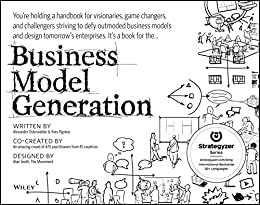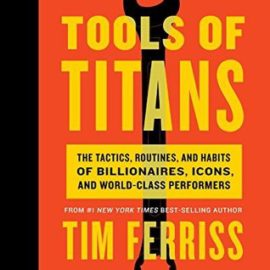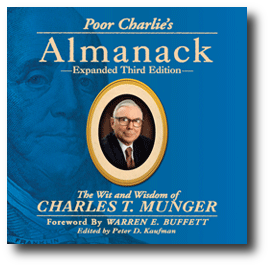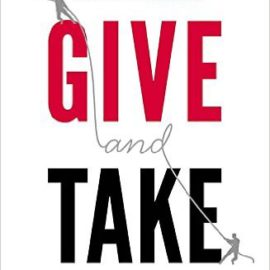

Want to get the main points of Business Model Generation in 20 minutes or less? Read the world’s #1 book summary of Business Model Generation by Alexander Osterwalder and Yves Pigneur here.
Business Model Generation is a book about systemic business innovation. It provides a template and process that allows teams to discuss and understand how business models have worked and are formed. Successful businesses thrive by creating holistic business models that take advantage of every available resource in their space. Customers lie at the heart of all business models, but the business model may approach them indirectly. Many tools can be used to approach business model brainstorming from a variety of different angles, such as the building block canvas.
Business Model Building Blocks
To help frame discussion about business models, the authors developed a ‘Business Model Canvas’ to help visually prompt analysis along important criteria. This is an attempt to systematize the creation of a business model by bringing together the elements that make up a successful business model and forcing questions to be asked for each one. The goal is to focus the discussion and attention on higher levels of strategic thinking without getting distracted by smaller operational details.
Because a business model is a dynamic system, it is unlikely that one can just pick and choose individual options for each building block. Certain choices in one area impose constraints or limits on another. Some options in different sections amplify each other if used together.
- Key Partners: Working together with other parties can help control market share and offer a superior product, just as joint-ventures and supplier links. Other options here include outsourcing or subcontracting.
- Key Activities: Each company has certain constant activities that lead to profits and keeping customers happy. Example: Visa and Ebay run platforms or networks that allow different parties to work together for everyone’s benefit.
- Value Proposition: Groups of benefits which incentivize clients to work with you over your competitors. Improving this category can be done by innovating new products or optimizing them to fit client needs better.
- Customer Relationships: Different industries and customers require different types of assistance. In some cases this may mean Ex: Amazon creates the platform for customer product reviews that others can also utilize.
- Customer Segments: Companies target specific groups of customers to gain competitive advantage in a few key areas. Depending on the type and quantity of customers targeted, this can mean a niche or a mass market business. Other businesses work with multiple groups simultaneously, such as marketplaces like credit cards who handle both the merchant and cardholder.
- Key Resources: Assets the company can use to gain a competitive advantage, as diverse as superior talent, copyrights, or land ownership.
- Channels: The company must be able to communicate with the customer beyond just advertising. Each product or service must have channels where customers can evaluate, interact with, and purchase products or services.
- Cost Structure: Your type of business determines the cost structure, which acts as a constraint on other parts of the business. Key questions here include fixed and variable expenses, opportunities for economies of scale, and luxury service that requires significant expense to scale.
- Revenue Streams: Acting as the arteries of the business model, revenue streams obtain income but impose certain constraints on operations. Different revenue streams call for different pricing setups, such as a subscription, licensing, or one-time payment fees.
Example
- Apple was not the first company to create a portable media player. However, it was able to succeed in the long run and dominate the market with the iPod because it had a more holistic business model. For example, its iPod was integrated with the iTunes software and store. Customers liked the easy process of searching, buying, and playing music. To make this happen, Apple needed to cut deals with large record companies to ensure it had a wide library that would satisfy customer wishes. Most of its revenue came from selling the iPods, not individual songs, but the iTunes store and library created a moat against competitors. Apple customers would not want to switch to a competitor who lacked songs they could get from Apple.
Business Model Patterns
When reviewing the attributes of successful business models, certain consistent patterns show up again and again. Below are five of the most common patterns to help provide a template of how the business blocks above fit together in a coherent form. These examples demonstrate how combining the discrete concepts above lead to certain synergies or tradeoffs that companies try to avoid.
Unbundled Models
An unbundled business model is where an organization splits off three different aspects into their own discrete identities. This pattern shows up frequently in the banking and telecom industries, where the company is really conducting multiple types of businesses. If the company remains completely integrated, it can be difficult to avoid having choices in one arm creating negative tradeoffs in another.
- Customer Relationship
- Product Innovation
- Company Infrastructure
For example, the banking industry used to have vertically integrated companies due to expensive outsourcing and concerns over secrecy. The competitive environment changed in the 21st century, as niche banking providers like transaction banks sprung up to target a specific niche. This has created a number of tradeoffs that make integrated companies difficult and encourage unbundling:
- The bank simultaneously advises wealthy clients and sells financial instruments. The former is a long-term business where clients are held, acquired, and lost based on the strength of the relationship.
- The bank wants to sell its financial instruments to competing banks for extra revenue, which could hurt its competitive position.
- There is opportunity for perverse incentives if a bank advises customers and offers its own products. Naturally the product division will want to sell more products, but the advisory division wants to give its clients the best possible advice. The best advice may not always be to buy the company’s product.
- A transaction platform business requires an economy of scale to keep costs low and an overall focus on efficiency. The financial instruments side needs to hire expensive talent and pay them large bonuses to remain competitive.
Long Tail
A long tail business model diversifies products. Instead of focusing on one blockbuster product, these companies try to sell a wide variety of products to a mass audience. The products are usually niche items whose sales may ebb and flow depending on the season or environment. The company does not need any one item to dominate the market, but thrives on the aggregate sales of all the products. Long Tail models need an efficient operation, low inventory costs, and access to or control of a mass market platform.
For instance, Book publishing is an industry that traditionally operated as focused products. Publishers offered premier services in editing, marketing, design, and printing that could only be supplied to a finite number of writers. As a result, they put in much effort into screening writer submissions for the very best ones.
Lulu.com flipped this model around and tried to serve the large number of aspiring authors who may not have found a chance in the old model. It removes barriers to entry. Rather than devoting resources to screening prospective authors to judge the few who would sell the best, they created an online marketplace that provides all the tools authors need to print and distribute their work. A traditional publisher makes a large amount of profit from a small number of best sellers, whereas Lulu.com doesn’t care how well any one particular author sells. Nor are they financially hurt by failure, because they have an economy of scale. In effect, Lulu.com fulfills both a Long Tail model and a multi-sided platform model simultaneously (see below).
Multi-sided Platform
Multi-sided platforms, which are often marketplaces, bring two different parties together to solve supply and demand on one platform. They have become a very powerful and successful business model after the rise of information technology.
The problem with multi-sided platforms is that the value for one side requires a large enough number of users on the other side. For example, video game consoles only will sell if they have quality games. But video game publishers will only want to design a game for that console if it has many users who will buy it.
A typical solution to this problem is subsidizing one side of the platform to attract users on the other side. Because the parties on both sides have different wants and needs, they are not charged the same way. Often one side can use a product for free, and the other side pays for both parties. They are willing to make that payment because by joining they will get access to a large number of users.
In any one platform market, there may be more than one viable solution. Historically within the video game industry, console publishers competed for market share of hardcore gamers who valued game quality, graphics, and speed. Console Publishers would sell expensive consoles at a loss to get a large user base. Meanwhile they would charge royalties for game studios to develop and sell games on its console. Game studios would agree to these royalties in exchange for the opportunity to sell games to a wide audience. Thus the publisher had the game studios subsidize the user base, which got consoles at affordable prices.
Nintendo, who was running into market problems, flipped this approach around. Instead of developing expensive systems with great graphics, it aimed at casual gamers who might not have ordinarily bought a video game console. These casual players were enticed by the unique Nintendo Wii motion-response hardware that allowed players to interact directly with the game by their real world movement. Because its consoles were cheaper, Nintendo could profit both from charging royalties to game studios and selling consoles to customers.
To look at a different industry, Google combines the free model with the multi-sided platform model. This allows its customers to make unlimited searches for free. They make money by generating such a large amount of user activity that advertisers will pay extra to reach such a vast audience. The more people searching on Google, the wider reach any single advertising campaign will have. In effect, the advertisers are subsidizing the customer searches.
Free
Free business models use the enticing prospect of free use to create large user bases. Free models have some similarities with the multi-sided platform model, but it may not have two parties interacting. Many companies that offer a free product subsidize it by having other parties pay to gain access to its user base.
Free business models usually sprout up in technology areas that allow for scale. Software companies generally have high upfront labor costs in maintaining enough skilled software developers who can design and maintain their programs. Once the program is designed, there is often little cost difference in having 10,000 users or 100,000 users.
Like this summary? Want to learn more from books than ever? You'll love my product Shortform.
Shortform has the world’s best guides to 1000+ nonfiction books and articles. Even better, it helps you remember what you read, so you can make your life better. What's special about Shortform:
- The world's highest quality book guides - we discuss the book's main ideas, with expert analysis and commentary expanding will beyond the book
- Interactive exercises that teach you to apply what you've learned
- Discussion communities - get the best advice from other readers
Sound like what you've been looking for? Sign up for a 5-day free trial here.
Other free business models can be more appropriately called freemium. Rather than having separate parties pay to gain access to their overall user base, they attract a wide audience and offer a premium service that will appeal to a small number of users. In effect, this small, dedicated group pays for additional features and subsidizes the rest of the free users. The low cost of adding extra users makes it reasonable to allow them to use the product for free, assuming there are enough people willing to pay for a premium version. For example, most Skype customers use the product for free, while a small subset of users is willing to pay for extra requirements such as calling landlines and mobile phones.
Bait & Hook
The Bait & Hook model involves a cheap upfront sale that leads to consistent income generation over time in order to use it. A popular example of this model comes from Gillette’s disposable razor blade. The initial product, in this case the razor, is sold at a loss or break-even point. This entices customers to buy it, seeing the low-cost initial investment to get started. The company makes its profits by selling a complementary or necessary part for the customer to continue using the product. So the company is rewarded for keeping customers happy over the long run and willing enough to keep buying additional razor blades after they run out. These additional products, often disposable, usually need to be made with high enough margins to sustain losses on selling the initial bait.
Open
Sometimes it can be better to openly collaborate with other organizations rather than rigidly protecting the IP one already owns. This can be done by crowdsourcing to a wide audience or connecting with small teams of specialists. The key part of the design is to reduce the friction between communicating corporate needs and problems with the right experts who know how to solve them.
For example, Procter & Gamble significantly improved the output of its R&D division by creating a larger collaboration group consisting of third party research groups, tech entrepreneurs, and its own retired employees. P&G had to make the upfront investment to build a ‘bridge’ to connect their internal teams with these external resources.
- Their scientists developed relationships with top researchers at universities and other companies.
- P&G creates or employs internet platforms to crowd source some of its research problems to experts. Those who contribute valuable solutions are rewarded financially.
- They created a web platform to keep in contact with its retirees who still have significant expertise and potential interest in helping out on an ad hoc basis.
Multiple business models (portfolio)
- The Swatch Group is a Swiss watch manufacturer who previously made luxury watches. In the later 20th century Japanese and Hong Kong competitors began to effectively challenge the Swiss watch-making industry. To respond to this challenge, they created the Swatch watch line as a quality product for a great price, which allowed them to compete effectively against the Japanese watch companies. Their luxury and low end brands used different business models to supply different industry needs.
Developing New Business Models
A powerful shortcut to creating a viable business model starts with looking inside the minds of potential customers. Companies often invest large sums in market research, but they don’t pay enough attention to the customer’s perspective in the product or business model design phase. Apple realized with the iPod that customers were not particularly interested in a digital media player; they wanted a low-friction way of acquiring all the music they wanted. During the height of online music piracy, Apple demonstrated that customers, contrary to conventional wisdom, were willing to pay for digital music instead of just pirating it.
Some companies do put considerable effort in connecting employees with prospective customers. However, many customers are not able to articulate what they want. They may also act the opposite of what they say. Some customers may be worth listening to, while others may be ones to ignore.
One way to cheaply view matters from the customer’s perspective is by employing an empathy map. A team can visually work on this process by drawing a large X on a chart to separate the chart into four quadrants. On the bottom, note what customers say and do. On the right, observe what they see from the environment, friends, and market. On top, hypothesize how they really think and feel. On the left, pay attention to what they may be hearing from peers, superiors, or influencers. For all of these, keep in mind their potential pain points as well as desired gains.
This process forces teams to think of key questions that they might not normally consider. For example, what emotions do prospective customers feel in certain situations? What do these emotions show about how we could target our product to better serve their needs or wants?
Examples:
- Zipcar is a company that allows customers to rent cars at an hourly rate in crowded urban areas without having to pay for maintenance and long-term storage. It created this idea by looking
- Easyjet realized that poorer customers still wanted to travel by plane. They made that possible by offering a low-cost product which allowed them to charge lower prices with fewer amenities. The customer group they targeted really valued that price: quality tradeoff, which allowed the business to flourish.
Brainstorming
A certain amount of controlled chaos is needed for truly fruitful creativity. Creating new business models is about challenging the orthodox view in key areas where it might be wrong. A simple approach for generating controlled chaos is using a two-phase approach of idea generation and synthesis. The goal of idea generation is to create a large number of potential ideas. Synthesis is where these ideas are narrowed down and refined to a few viable options, potentially by combining multiple ideas together.
When consulting, the authors utilize a physical canvas combined with post-it notes to allow everyone on the team to visualize the problem together. By rearranging post-its, team members can quickly show how certain business model design choices affect other parts of the system. Members can quickly add and remove notes as part of the idea generation and synthesis phases. This approach is at its core a building block method, with the caveat that these blocks exist in a system and often have a complex set of interactions that may not be initially obvious.
Epicenters of Business Model Innovation
When assessing different business model options, it’s important to keep in mind what factors act as catalysts towards a new business model. Four patterns consistently come up and are worth keeping in mind as epicenters of creating model change. They can be combined and don’t have to stand alone.
- Resource-driven. Ex: Amazon web services used its existing retail infrastructure to allow cloud storage to other companies who lacked that infrastructure.
- Offer-driven. Ex: Cement maker Cemex promised to deliver poured cement within four hours of ordering instead of the industry-standard 48.
- Customer-driven: 23andMe personalized DNA testing to the mass market, when it had been previously available to only health professionals.
- Finance-driven. Ex: Xerox couldn’t sell its copying machines at a price high enough to make a profit. So it leased the machines at $95/month, with 2,000 free copies, and charged 5 cents for each extra copy over that limit.
Ideation Process Questions
- Is our team sufficiently diverse to create quality new ideas?
- What environmental aspects should we immerse ourselves in prior to generating business model ideas?
- What kinds of innovations can we imagine for all of the 9 building blocks?
- What are the most critical criteria that we can use to prioritize business model ideas?
- How can we prototype our ideas? How would each of our finalized models work?
Designer tactics
It’s important for business teams to operate with the mentality of a designer, not just a businessperson who follows a process. For example, What-if Questions can be very powerful at allowing our minds to break free of the status quo and reach conclusions we would otherwise be blind to. Fictional storytelling is also a powerful way to connect with prospective customers and get an idea for how a prospective business model brings all the disparate parts together. This can also be done by writing out scenarios or visually showing links between ideas on post-it notes.
Some parts of the creative process can be improved by adjusting the level of commitment towards a new idea. Here, it is ideal to find a middle ground in areas like committing to a solution too early and freezing the product design too soon. Creativity is an iterative process, and it is more difficult to keep iterating if your team already has fallen in love with an idea or mentally closed off further innovation too early. Rather, it can be better to develop crude models that are difficult to become overly attached to. That keeps people constantly looking for more ways to improve them instead of becoming satisfied. A good way to do this is by sketching out different levels of prototyping, starting on a napkin and the business model canvas to actual field tests.
Reviewing
All business models eventually become obsolete, so companies need to be proactive in generating new ones. One should not wait until a crisis is looming to reevaluate the business model. The best way to be proactive is to make reviewing the existing business model a habitual activity. Not only does this make it more likely your team can spot potential problems or opportunities within the current business model, it also improves your internal skill at evaluating and creating business model improvements. Over time, this practice will help your team shake free of old assumptions that are no longer true.
A robust business model includes environmental constraints.
- Macroeconomic Conditions
- Competitive Pressures
- Industry Trends
- Customer Demands
Within these reviewing sessions, an easy place to start is with a Strengths, Weaknesses, Opportunities, and Threats (SWOT) model applied to each of the nine business model blocks. The SWOT approach makes it convenient to reevaluate the current situation of each aspect of the business model within present conditions. It also forces the team to think about potential changes to the industry ahead of time. A review does not mean a business model needs to be completely overhauled or kept as is. It can be helpful to simply target one area of the model and optimize it slightly better. For example, Nestle improved its overall business model by focusing on channel expansion. It had a viable product line in Nespresso coffee and coffee machines. However, it was unable to make consistent gains in selling to offices and restaurants, even though these seemed like natural outlets for the product. The problem was solved by switching the target customer base for coffee machines to high-income households and selling capsules via mail. In the 2000’s Nespresso saw an average growth rate of over 35% annually.






